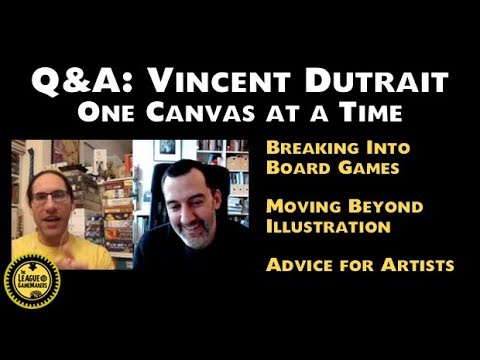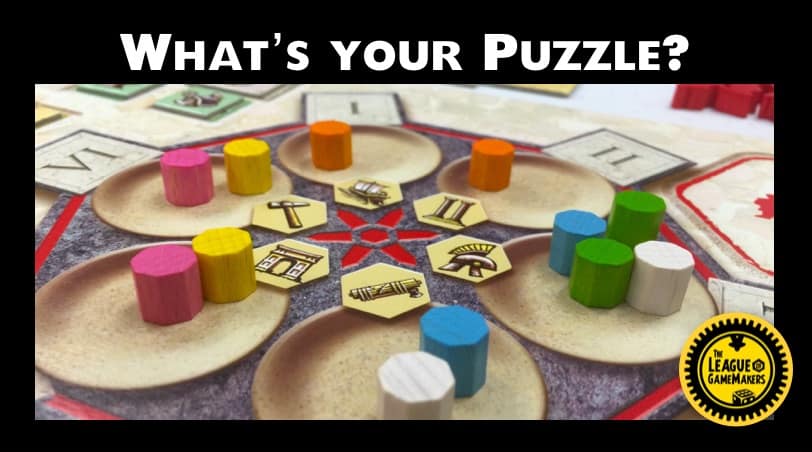
While many tabletop games focus on particular strengths, there are certain things that basically all games need to be successful: a cohesive aesthetic, ways for players to interact, clear goals and actions that lead to completing those goals. Having so many aspects is one of the things that makes tabletop games so great!
Today I want to discuss one important feature of games that I think is often underappreciated: the puzzle. While games don’t necessarily need to include puzzles, I believe almost all games benefit from having them, so it’s worth your time as a designer to consider what your game’s puzzle is and to make sure it’s fun.
WHAT’S A PUZZLE?
What do I mean by a puzzle? I certainly don’t mean a classic jigsaw puzzle. I mean something for the players to ponder. It’s the structure that gives your players’ decisions meaning. Puzzles can take many forms, but perhaps they’re easiest to understand by considering a few examples.
In Chess, each board state presents a unique puzzle where a player needs to determine how to leverage their position to put pressure on their opponent. Advancing a pawn might threaten your opponent’s rook, but leave your knight open for counter-attack. It’s the player’s job to think through the consequences of each action to determine the best option. If a player doesn’t enjoy solving those sorts of puzzles, she won’t enjoy Chess.
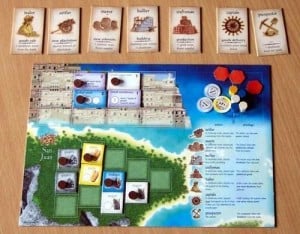
In games like Puerto Rico, players must chain actions to convert resources into precious victory points. Image from Board Game Geek.
In many euro games such as Puerto Rico, the puzzle is how to convert resources, including time, efficiently. You know you want victory points, but to gain victory points you’ll need to build buildings, which requires wood, stone, and gold. But you’ve already logged all of your forests. How will you come by that precious wood with only two turns left in the game?
In hidden identity games like Avalon, the puzzle is figuring out who’s on your team. Every statement and action a player makes is a potential clue about their true identity, and players must reason with these clues to determine who the real bad guys are.
Tile laying games like Carcassonne or my upcoming title Trellis feature visual puzzles, where players must reason through the consequences of adding a tile to the growing board in various orientations. This uses different skills than numerical reasoning but can be extremely intuitive and satisfying.
Codenames is quickly becoming a modern classic, partly because it does such a great job of combining a party game atmosphere with a very clean puzzle system. The codemaster gives her team a single word clue followed by a number, and the team’s job is to determine which code words the clue implies. Both parties have interesting puzzles to solve: for the codemaster, how can you associate as many of your words as possible without leading your team astray or being too cryptic? For the team, what’s the most likely combination of words that the codemaster intended to indicate with her clue? Why would she have chosen that particular clue rather than another one that might have been more clear, unless the more clear word indicates a word for the other team or the dreaded assassin?
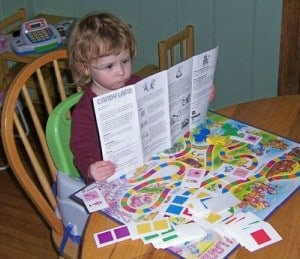
Even straight forward games like Candyland can provide puzzles for novice gamers. Image from Board Game Geek.
Almost every game you’ll play has some puzzle aspect, and the few that don’t tend to be completely determined by chance. Even these games (like Candyland or Snakes and Ladders) have some puzzle aspects, though: How good is a red card for me now? Which die rolls are good for me, and which ones send me back to the beginning of the game? For young gamers, reasoning through these puzzles can be as informative and interesting as an advanced gamer determining when to switch from engine-building to victory point collecting in Dominion.
WHY PUZZLES?
Why should you care about your game’s puzzle? There are many good reasons.
First, solving puzzles and using logical thinking is one of the great joys of playing games. It gives people a challenge to overcome and an opportunity to feel smart. The real world is messy, chaotic, and often frustrating; most games are clean and simple, and definitively overcoming obstacles can be very satisfying.
Second, while almost all players enjoy puzzles, some players play games specifically to solve puzzles. They’re less interested in interacting with other players; they’d be just as happy playing against bots, or thinking of their fellow humans as a part of the game system. But they very much enjoy breaking the game designer’s system. It’s important to provide something for these players!
Third, it gives players something to think about during downtime. Almost all games have some time when a player is sitting around doing nothing, often times waiting for other players. Why not provide something to occupy that otherwise blank time?
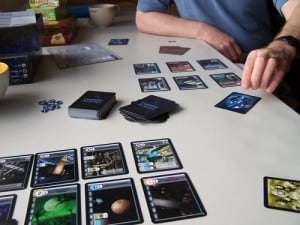
In games like Race for the Galaxy, solving puzzles involves anticipating your opponents’ actions, a clean form of interaction. Image from Board Game Geek.
Finally, puzzles provide a great way to include and focus player interaction in a game. As I discussed in my Game Elements article on interaction, presenting puzzles lets players interact with one another in a structured and challenging way. When solving a puzzle involves thinking about the other player’s potential actions, as it does when trading for resources in Catan, players are forced to interact with each other in a very clear way.
PERFECT PUZZLES
How do you know if your game’s puzzles are any good? Playtesting, of course! Watch players playing your game and try to determine if they’re enjoying reasoning through the individual decisions they have to make on a turn by turn basis.
But you can also test it yourself. Try solving some random puzzles that might show up in your game, but outside of the context of a full game. If your euro game has a market phase where players convert resources, give yourself some random resources and see if you enjoy figuring out how to make gold out of lead, even if you don’t have anything to do with that gold. Was it fun? Great! Now repeat that a few dozen times. Are you still having fun? Do you feel like new challenges still present themselves, or do you feel like you can do the conversions on autopilot? Obviously context will make solving puzzles like that more meaningful, but your players will be solving these puzzles over and over again even in a single game. Make sure that the puzzles are fun to solve on their own and that they don’t turn into busy work.
Another word to the wise: make sure bypassing puzzles isn’t a good strategy in your game. Puzzles should be some of the central fun of your game, and if your players can do well by ignoring them, your game isn’t as fun as it could be. Make sure that your game incentivises your players to do what’s fun.
So, what’s your puzzle? If you don’t have a good answer to that question, it’s time to rethink your game. Not only do you want an answer to that question, you want a good one. Your players will thank you.

